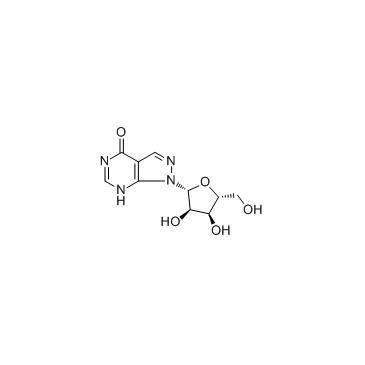Allopurinol riboside (Synonyms: Allopurinol Ribonucleoside, NSC 138437, NSC 252629) |
| Katalog-Nr.GC35295 |
Allopurinol-Ribosid, ein Metabolit von Allopurinol, zeigt starke AktivitÄten gegen Parasiten.
Products are for research use only. Not for human use. We do not sell to patients.

Cas No.: 16220-07-8
Sample solution is provided at 25 µL, 10mM.
Allopurinol riboside, a metabolite of allopurinol, shows potent activities against parasites. Human Endogenous Metabolite
Allopurinol-riboside competitively inhibits the action of purine nucleoside phosphorylase on inosine with a Ki of 277 μM. Lymphocyte blastogensis induced by PHA and Con A is significantly suppressed by allopurinol-riboside in a concentration-dependent manner. When LPS is used as a mitogen, the inhibition of allopurinol-ribosideon lymphocyte proliferation is less marked. Humoral immunity is not suppressed by allopurinol-riboside[1]. Allopurinol riboside is an experimental agent for the treatment of leishmaniasis and American trypanosomiasis. Allopurinol riboside is effective against parasites, because a series of enzymes (analogous to those that mediate purine salvage in humans) convert it into 4-aminopyrazolopyrimidine ribonucleoside triphosphate, a cytotoxic product. Allopurinol riboside is selectively toxic, because it is not metabolized by the corresponding enzymes in humans[2].
Allopurinol riboside peaks in plasma 1.6 hours after administration, has an elimination half-life of 3 hours, and steady-state concentrations in the therapeutic range[3]. After oral administration, unexpectedly low levels of allopurinol riboside in plasma are attributable to incomplete absorption and rapid renal clearance. Probenecid reduces the renal clearance of allopurinol riboside, extends the half-life of allopurinol riboside in plasma, and triples the levels of allopurinol riboside in plasma[4].
[1]. Nishida Y, et al. Inhibition of purine nucleoside phosphorylase activity and of T-cell function with allopurinol-riboside. Agents Actions. 1979 Dec;9(5-6):549-52. [2]. Pacher P, et al. Therapeutic effects of xanthine oxidase inhibitors: renaissance half a century after the discovery of allopurinol. Pharmacol Rev. 2006 Mar;58(1):87-114. [3]. Shapiro TA, et al. Pharmacokinetics and metabolism of allopurinol riboside. Clin Pharmacol Ther. 1991 May;49(5):506-14. [4]. Were JB, et al. Effects of probenecid on the pharmacokinetics of allopurinol riboside. Antimicrob Agents Chemother. 1993 May;37(5):1193-6.
| Cas No. | 16220-07-8 | SDF | |
| Überlieferungen | Allopurinol Ribonucleoside, NSC 138437, NSC 252629 | ||
| Canonical SMILES | O=C1C2=C(N([C@H]3[C@H](O)[C@H](O)[C@@H](CO)O3)N=C2)NC=N1 | ||
| Formula | C10H12N4O5 | M.Wt | 268.23 |
| Löslichkeit | DMSO : 100 mg/mL (372.81 mM; Need ultrasonic) | Storage | Store at -20°C |
| General tips | Please select the appropriate solvent to prepare the stock solution according to the
solubility of the product in different solvents; once the solution is prepared, please store it in
separate packages to avoid product failure caused by repeated freezing and thawing.Storage method
and period of the stock solution: When stored at -80°C, please use it within 6 months; when stored
at -20°C, please use it within 1 month. To increase solubility, heat the tube to 37°C and then oscillate in an ultrasonic bath for some time. |
||
| Shipping Condition | Evaluation sample solution: shipped with blue ice. All other sizes available: with RT, or with Blue Ice upon request. | ||
| Prepare stock solution | |||

|
1 mg | 5 mg | 10 mg |
| 1 mM | 3.7281 mL | 18.6407 mL | 37.2814 mL |
| 5 mM | 0.7456 mL | 3.7281 mL | 7.4563 mL |
| 10 mM | 0.3728 mL | 1.8641 mL | 3.7281 mL |
Step 1: Enter information below (Recommended: An additional animal making an allowance for loss during the experiment)
 g
g
 μL
μL

Step 2: Enter the in vivo formulation (This is only the calculator, not formulation. Please contact us first if there is no in vivo formulation at the solubility Section.)
Calculation results:
Working concentration: mg/ml;
Method for preparing DMSO master liquid: mg drug pre-dissolved in μL DMSO ( Master liquid concentration mg/mL, Please contact us first if the concentration exceeds the DMSO solubility of the batch of drug. )
Method for preparing in vivo formulation: Take μL DMSO master liquid, next addμL PEG300, mix and clarify, next addμL Tween 80, mix and clarify, next add μL ddH2O, mix and clarify.
Method for preparing in vivo formulation: Take μL DMSO master liquid, next add μL Corn oil, mix and clarify.
Note: 1. Please make sure the liquid is clear before adding the next solvent.
2. Be sure to add the solvent(s) in order. You must ensure that the solution obtained, in the previous addition, is a clear solution before proceeding to add the next solvent. Physical methods such as vortex, ultrasound or hot water bath can be used to aid dissolving.
3. All of the above co-solvents are available for purchase on the GlpBio website.
Quality Control & SDS
- View current batch:
- Purity: >98.00%
- COA (Certificate Of Analysis)
- SDS (Safety Data Sheet)
- Datasheet
Average Rating: 5 (Based on Reviews and 2 reference(s) in Google Scholar.)
GLPBIO products are for RESEARCH USE ONLY. Please make sure your review or question is research based.
Required fields are marked with *



















